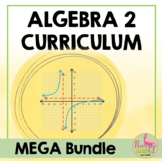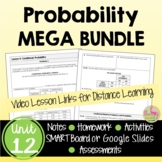Conditional Probability (Algebra 2 - Unit 12)
- Zip
- Google Apps™

Also included in
- ALGEBRA 2 CURRICULUM MEGA BUNDLE What does the curriculum include?This resource is designed for students enrolled in ALGEBRA 2 HONORS. You will find more than 1900+ pages of instructional content (warm-ups, Guided Notes and Foldables, Google Slides, SMART Board slides, video lessons, homework, dailPrice $535.00Original Price $675.44Save $140.44
- This is a MEGA Bundle of foldables, guided notes, homework, daily content quizzes, mid-unit and end-unit assessments, review assignments, and cooperative activities Algebra 2 Honors UNIT 12: PROBABILITY. The unit includes 5 lessons which are presented to students using two different note-taking techPrice $36.50Original Price $45.50Save $9.00
Description
Conditional Probability Algebra 2 Lesson:
Your Pre-AP Algebra 2 Honors students will determine conditional probabilities, use tree diagrams and two-way tables in this Unit 12 lesson. #distancelearningtpt
What is included in this resource?
⭐ Guided Student Notes
⭐ Google Slides®
⭐ Fully-editable SMART Board® Slides
⭐ Homework/Practice assignment
⭐ Lesson Warm-Up (or exit ticket)
⭐ Daily Content Quiz (homework check)
⭐ Video Lesson Link for Distance Learning - Flipped Classroom models
⭐ Full solution set
Students will be able to:
★ Determine conditional probabilities
★ Interpret data and relationships by using formulas and tree diagrams
**(3/3/2022) Corrected Homework Key problem #5& #18, changed wording on #13
The unit includes the following topics:
1) Permutations and Combinations
2) Theoretical and Experimental Probability
3) Independent and Dependent Events
4) Conditional Probability
You may also be interested in:
Probability Activities and Assessments
****************************************************************
I LOVE FEEDBACK
Remember to leave feedback and you will earn points toward FREE TPT purchases. I love that feedback!
Also, follow me to be notified about my new products, sales, updates, and FREEBIES!
If you have any questions, comments or special requests
please contact me by email at: jean@flamingomath.com
Thanks for shopping in my store!
Jean Adams




